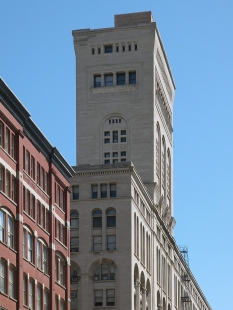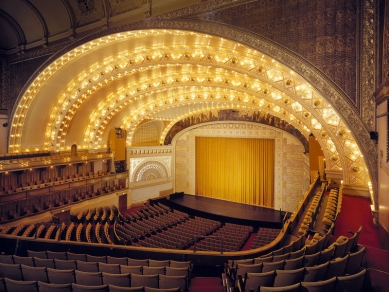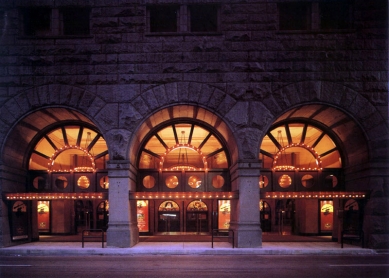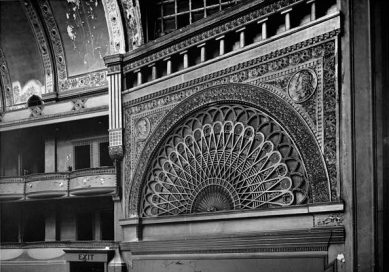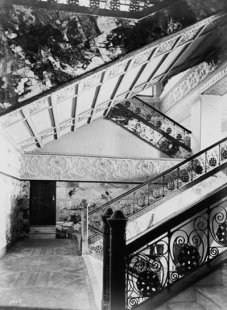
Auditorium Building
Auditorium Theatre of Roosevelt University

The Auditorium Building was considered the biggest thing in Chicago since the fire of 1871. Louis Sullivan began preliminary sketches in 1886, and the building was completed in 1890, costing $3,200,000. 63,350 square feet of space were divided into a four-hundred room hotel on Michigan and Congress Parkway, a business section for 136 offices and stores on Wabash, and a 4,200 seat theater in the tower.
The extraordinary engineering talent of Dankmar Adler and the architectural genius of Louis H. Sullivan created this building to reflect the cultural maturity of Chicago. Combining hotel and office space with a splendid theater designed for an opera company, the Auditorium was a turning point in Sullivan's career and a milestone in the development of modern architecture.
Sullivan's genius for architectural ornamentation is displayed in the building's interior, where most of the public rooms are lavishly finished. The grandest interior space is the theater itself, with four broad elliptical arches spanning the width of the theater and decorated by plaster reliefs covered with gold leaf.
The Auditorium Building was designed by Dankmar Adler and Louis Sullivan (1886–90).The Auditorium Building in Chicago, Illinois is one of the best-known designs of Dankmar Adler and Louis Sullivan. The building is located at 430 South Michigan Avenue (the northwest corner of Michigan Avenue and Congress Parkway). It originally housed a large opera house, a hotel, and numerous offices.
The Auditorium Theatre, a National Historic Landmark, is part of the Auditorium Building. Today the Auditorium Building is the home of Roosevelt University.
Origin and purpose
Ferdinand Peck, a Chicago businessman, incorporated the Chicago Auditorium Association in December 1886 to develop what he wanted to be the world's largest, grandest, most expensive theater that would rival such institutions as the Metropolitan Opera House in New York City. He was said to have wanted to make high culture accessible to the working classes of Chicago.
The building was to include an office block and a first class hotel. Peck persuaded many Chicago business tycoons to go on board with him, including Marshall Field, Edson Keith, Martin Ryerson, and George Pullman. The association hired the renowned architectural firm of Dankmar Adler and Louis Sullivan to design the building. At the time, a young Frank Lloyd Wright was employed at the firm as draftsman.
Design
Adler and Sullivan designed a tall structure with load-bearing outer walls, and based the exterior appearance partly on the design of H.H. Richardson's Marshall Field Warehouse, another Chicago landmark. The Auditorium is a heavy, impressive structure externally, and was more striking in its day when buildings of its scale were less common. When completed, it was the tallest building in the city.
One of the most innovative features of the building was its massive raft foundation, designed by Adler in conjunction with engineer Paul Mueller. The soil beneath the Auditorium consists of soft blue clay to a depth of over 100 feet, which made conventional foundations impossible. Adler and Mueller designed a floating mat of crisscrossed railroad ties, topped with a double layer of steel rails embedded in concrete, the whole assemblage coated with pitch.
The resulting raft allowed the weight of the massive outer walls to be distributed over a large area. However, the weight of the masonry outer walls in relation to the relatively lightweight interior deformed the raft over the course of a century, and today portions of the building have settled as much as 29 inches. This deflection is clearly visible in the theater lobby, where the mosaic floor takes on a distinct slope as it nears the outer walls. This settlement is not because of poor engineering but the fact the design was changed during construction. The original plan had the exterior covered in lightweight terra-cotta, but this was changed to stone after the foundations were under construction. Most of the settlement occurred within a decade after construction, and at one time there was a plan to shorten the interior supports to level the floors but this was never carried out.
In the center of the building was a 4,300 seat auditorium, originally intended primarily for production of Grand Opera. In keeping with Peck's democratic ideals, the auditorium was designed so that all seats would have good views and acoustics. The original plans had no box seats at all, and when these were added to the plans they did not get the prime locations.
Housed in the building around this central space were 136 offices and a 400-room hotel, whose purpose was to generate much of the revenue to support the opera. While the Auditorium Building was not intended as a commercial building, Peck wanted it to be self-sufficient. Revenue from the offices and hotel was meant to allow ticket prices to remain reasonable. In reality, both the hotel and office block became unprofitable within a few years.
History
On October 5, 1887, President Grover Cleveland laid the cornerstone for the Auditorium Building. The 1888 Republican National Convention was held in a partially finished building where Benjamin Harrison was nominated as a presidential candidate. On December 9, 1889 President Benjamin Harrison dedicated the building and Adler and Sullivan opened their offices on the 16th and 17th floors of the Auditorium tower.
The Chicago Symphony Orchestra debuted on October 16, 1891 and made its home in the Auditorium Theatre until moving to Orchestra Hall in 1904. Theodore Roosevelt gave his famous Bull Moose speech in 1912 at the Auditorium and was nominated for President of the United States by the independent National Progressive Party.
The opera company renting the accommodation moved to the Civic Opera House in 1929, and the Auditorium Theatre closed during the Great Depression. In 1941 it was taken over by the city of Chicago to be used as a World War II servicemen's center. By 1946, Roosevelt University moved into the Auditorium Building, but the theater was not restored to its former splendor.
On October 31, 1967 the Auditorium Theatre reopened and through 1975, the Auditorium served as Chicago's premier rock venue with performances by Jimi Hendrix, The Who, The Grateful Dead, and many others. It was declared a National Historic Landmark by the U.S. Department of the Interior in 1975.
In 2001, a major restoration of the Auditorium Theatre was begun to return the theater to its original colors and finishes.
„The Auditorium was built for a syndicate of businessmen to house a large civic opera house; to provide an economic base it was decided to wrap the auditorium with a hotel and office block. Hence Adler & Sullivan had to plan a complex multiple-use building. Fronting on Michigan Avenue, overlooking the lake, was the hotel (now Roosevelt University) while the offices were placed to the west on Wabash Avenue. The entrance to the auditorium is on the south side beneath the tall blocky seventeen-story tower. The rest of the building is a uniform ten stories, organized in the same way as Richardson's Marshall Field Wholesale Store. The interior embellishment, however, is wholly Sullivan's, and some of the details, because of their continuous curvilinear foliate motifs, are among the nearest equivalents to European Art Nouveau architecture.“
„Some interior details were probably drawn by Frank Lloyd Wright, who started in Sullivan's office as a draftsman in 1887.“
The extraordinary engineering talent of Dankmar Adler and the architectural genius of Louis H. Sullivan created this building to reflect the cultural maturity of Chicago. Combining hotel and office space with a splendid theater designed for an opera company, the Auditorium was a turning point in Sullivan's career and a milestone in the development of modern architecture.
Sullivan's genius for architectural ornamentation is displayed in the building's interior, where most of the public rooms are lavishly finished. The grandest interior space is the theater itself, with four broad elliptical arches spanning the width of the theater and decorated by plaster reliefs covered with gold leaf.
The Auditorium Building was designed by Dankmar Adler and Louis Sullivan (1886–90).The Auditorium Building in Chicago, Illinois is one of the best-known designs of Dankmar Adler and Louis Sullivan. The building is located at 430 South Michigan Avenue (the northwest corner of Michigan Avenue and Congress Parkway). It originally housed a large opera house, a hotel, and numerous offices.
The Auditorium Theatre, a National Historic Landmark, is part of the Auditorium Building. Today the Auditorium Building is the home of Roosevelt University.
Origin and purpose
Ferdinand Peck, a Chicago businessman, incorporated the Chicago Auditorium Association in December 1886 to develop what he wanted to be the world's largest, grandest, most expensive theater that would rival such institutions as the Metropolitan Opera House in New York City. He was said to have wanted to make high culture accessible to the working classes of Chicago.
The building was to include an office block and a first class hotel. Peck persuaded many Chicago business tycoons to go on board with him, including Marshall Field, Edson Keith, Martin Ryerson, and George Pullman. The association hired the renowned architectural firm of Dankmar Adler and Louis Sullivan to design the building. At the time, a young Frank Lloyd Wright was employed at the firm as draftsman.
Design
Adler and Sullivan designed a tall structure with load-bearing outer walls, and based the exterior appearance partly on the design of H.H. Richardson's Marshall Field Warehouse, another Chicago landmark. The Auditorium is a heavy, impressive structure externally, and was more striking in its day when buildings of its scale were less common. When completed, it was the tallest building in the city.
One of the most innovative features of the building was its massive raft foundation, designed by Adler in conjunction with engineer Paul Mueller. The soil beneath the Auditorium consists of soft blue clay to a depth of over 100 feet, which made conventional foundations impossible. Adler and Mueller designed a floating mat of crisscrossed railroad ties, topped with a double layer of steel rails embedded in concrete, the whole assemblage coated with pitch.
The resulting raft allowed the weight of the massive outer walls to be distributed over a large area. However, the weight of the masonry outer walls in relation to the relatively lightweight interior deformed the raft over the course of a century, and today portions of the building have settled as much as 29 inches. This deflection is clearly visible in the theater lobby, where the mosaic floor takes on a distinct slope as it nears the outer walls. This settlement is not because of poor engineering but the fact the design was changed during construction. The original plan had the exterior covered in lightweight terra-cotta, but this was changed to stone after the foundations were under construction. Most of the settlement occurred within a decade after construction, and at one time there was a plan to shorten the interior supports to level the floors but this was never carried out.
In the center of the building was a 4,300 seat auditorium, originally intended primarily for production of Grand Opera. In keeping with Peck's democratic ideals, the auditorium was designed so that all seats would have good views and acoustics. The original plans had no box seats at all, and when these were added to the plans they did not get the prime locations.
Housed in the building around this central space were 136 offices and a 400-room hotel, whose purpose was to generate much of the revenue to support the opera. While the Auditorium Building was not intended as a commercial building, Peck wanted it to be self-sufficient. Revenue from the offices and hotel was meant to allow ticket prices to remain reasonable. In reality, both the hotel and office block became unprofitable within a few years.
History
On October 5, 1887, President Grover Cleveland laid the cornerstone for the Auditorium Building. The 1888 Republican National Convention was held in a partially finished building where Benjamin Harrison was nominated as a presidential candidate. On December 9, 1889 President Benjamin Harrison dedicated the building and Adler and Sullivan opened their offices on the 16th and 17th floors of the Auditorium tower.
The Chicago Symphony Orchestra debuted on October 16, 1891 and made its home in the Auditorium Theatre until moving to Orchestra Hall in 1904. Theodore Roosevelt gave his famous Bull Moose speech in 1912 at the Auditorium and was nominated for President of the United States by the independent National Progressive Party.
The opera company renting the accommodation moved to the Civic Opera House in 1929, and the Auditorium Theatre closed during the Great Depression. In 1941 it was taken over by the city of Chicago to be used as a World War II servicemen's center. By 1946, Roosevelt University moved into the Auditorium Building, but the theater was not restored to its former splendor.
On October 31, 1967 the Auditorium Theatre reopened and through 1975, the Auditorium served as Chicago's premier rock venue with performances by Jimi Hendrix, The Who, The Grateful Dead, and many others. It was declared a National Historic Landmark by the U.S. Department of the Interior in 1975.
In 2001, a major restoration of the Auditorium Theatre was begun to return the theater to its original colors and finishes.
„The Auditorium was built for a syndicate of businessmen to house a large civic opera house; to provide an economic base it was decided to wrap the auditorium with a hotel and office block. Hence Adler & Sullivan had to plan a complex multiple-use building. Fronting on Michigan Avenue, overlooking the lake, was the hotel (now Roosevelt University) while the offices were placed to the west on Wabash Avenue. The entrance to the auditorium is on the south side beneath the tall blocky seventeen-story tower. The rest of the building is a uniform ten stories, organized in the same way as Richardson's Marshall Field Wholesale Store. The interior embellishment, however, is wholly Sullivan's, and some of the details, because of their continuous curvilinear foliate motifs, are among the nearest equivalents to European Art Nouveau architecture.“
Leland M. Roth. A Concise History of American Architecture. p.179-80
„Some interior details were probably drawn by Frank Lloyd Wright, who started in Sullivan's office as a draftsman in 1887.“
Sir Banister Fletcher. A History of Architecture. p.1241
0 comments
add comment




